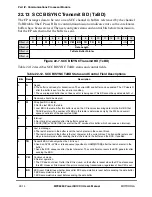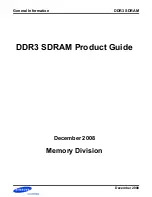
MOTOROLA
Chapter 22. SCC BISYNC Mode
22-1
Chapter 22
SCC BISYNC Mode
220
220
The byte-oriented BISYNC protocol was developed by IBM for use in networking
products. There are three classes of BISYNC framesÑtransparent, nontransparent with
header, and nontransparent without header, shown in Figure 22-1. The transparent frame
type in BISYNC is not related to transparent mode, discussed in Chapter 23, ÒSCC
Transparent Mode.Ó Transparent BISYNC mode allows full binary data to be sent with any
possible character pattern. Each class of frame starts with a standard two-octet
synchronization pattern and ends with a block check code (BCC). The end-of-text character
(ETX) is used to separate the text and BCC Þelds.
Figure 22-1. Classes of BISYNC Frames
The bulk of a frame is divided into Þelds whose meaning depends on the frame type. The
BCC is a 16-bit CRC format if 8-bit characters are used; it is a combination longitudinal
(sum check) and vertical (parity) redundancy check if 7-bit characters are used. In
transparent operation, a special character (DLE) is deÞned that tells the receiver that the
next character is text, allowing BISYNC control characters to be valid text data in a frame.
A DLE sent as data must be preceded by a DLE character. This is sometimes called byte-
stufÞng. The physical layer of the BISYNC communications link must synchronize the
receiver and transmitter, usually by sending at least one pair of synchronization characters
before each frame.
BISYNC protocol is unusual in that a transmit underrun need not be an error. If an underrun
occurs, a synchronization pattern is sent until data is again ready. In nontransparent
operation, the receiver discards additional synchronization characters (SYNCs) as they are
received. In transparent mode, DLE-SYNC pairs are discarded. Normally, for proper
Nontransparent with Header
SYN1
SYN2
SOH
Header
STX
Text
ETX
BCC
Nontransparent without Header
SYN1
SYN2
STX
Text
ETX
BCC
Transparent
SYN1
SYN2
DLE
STX
Transparent
Text
DLE
ETX
BCC
Summary of Contents for MPC8260 PowerQUICC II
Page 1: ...MPC8260UM D 4 1999 Rev 0 MPC8260 PowerQUICC II UserÕs Manual ª ª ...
Page 66: ...lxvi MPC8260 PowerQUICC II UserÕs Manual MOTOROLA ...
Page 88: ...1 18 MPC8260 PowerQUICC II UserÕs Manual MOTOROLA Part I Overview ...
Page 120: ...2 32 MPC8260 PowerQUICC II UserÕs Manual MOTOROLA Part I Overview ...
Page 138: ...Part II iv MPC8260 PowerQUICC II UserÕs Manual MOTOROLA Part II Configuration and Reset ...
Page 184: ...4 46 MPC8260 PowerQUICC II UserÕs Manual MOTOROLA Part II ConÞguration and Reset ...
Page 202: ...Part III vi MPC8260 PowerQUICC II UserÕs Manual MOTOROLA Part III The Hardware Interface ...
Page 266: ...8 34 MPC8260 PowerQUICC II UserÕs Manual MOTOROLA Part III The Hardware Interface ...
Page 382: ...10 106 MPC8260 PowerQUICC II UserÕs Manual MOTOROLA Part III The Hardware Interface ...
Page 392: ...11 10 MPC8260 PowerQUICC II UserÕs Manual MOTOROLA Part III The Hardware Interface ...
Page 430: ...Part IV viii MOTOROLA Part IV Communications Processor Module ...
Page 490: ...14 36 MPC8260 PowerQUICC II UserÕs Manual MOTOROLA Part IV Communications Processor Module ...
Page 524: ...17 10 MPC8260 PowerQUICC II UserÕs Manual MOTOROLA Part IV Communications Processor Module ...
Page 556: ...18 32 MPC8260 PowerQUICC II UserÕs Manual MOTOROLA Part IV Communications Processor Module ...
Page 584: ...19 28 MPC8260 PowerQUICC II UserÕs Manual MOTOROLA Part IV Communications Processor Module ...
Page 632: ...21 24 MPC8260 PowerQUICC II UserÕs Manual MOTOROLA Part IV Communications Processor Module ...
Page 652: ...22 20 MPC8260 PowerQUICC II UserÕs Manual MOTOROLA Part IV Communications Processor Module ...
Page 668: ...23 16 MPC8260 PowerQUICC II UserÕs Manual MOTOROLA Part IV Communications Processor Module ...
Page 758: ...27 28 MPC8260 PowerQUICC II UserÕs Manual MOTOROLA Part IV Communications Processor Module ...
Page 780: ...28 22 MPC8260 PowerQUICC II UserÕs Manual MOTOROLA Part IV Communications Processor Module ...
Page 874: ...29 94 MPC8260 PowerQUICC II UserÕs Manual MOTOROLA Part IV Communications Processor Module ...
Page 920: ...31 18 MPC8260 PowerQUICC II UserÕs Manual MOTOROLA Part IV Communications Processor Module ...
Page 980: ...A 4 MPC8260 PowerQUICC II UserÕs Manual MOTOROLA Appendixes ...
Page 1002: ...Index 22 MPC8260 PowerQUICC II UserÕs Manual MOTOROLA INDEX ...
Page 1006: ......















































